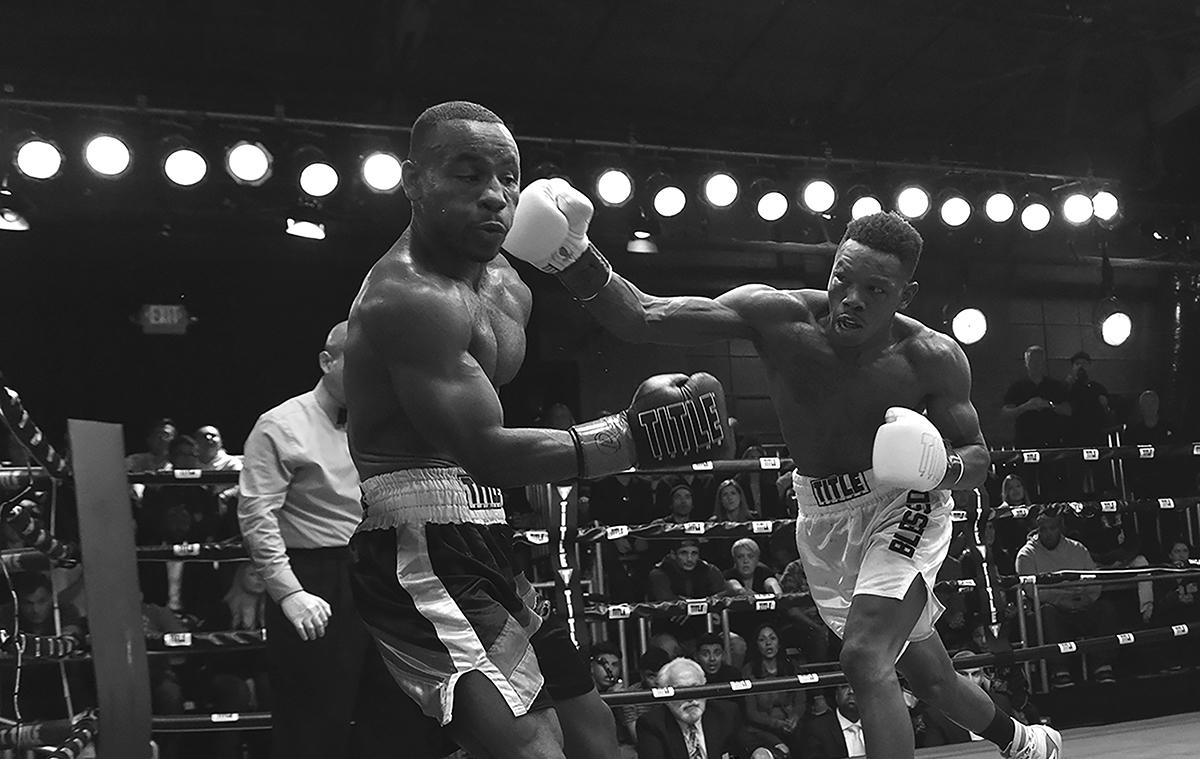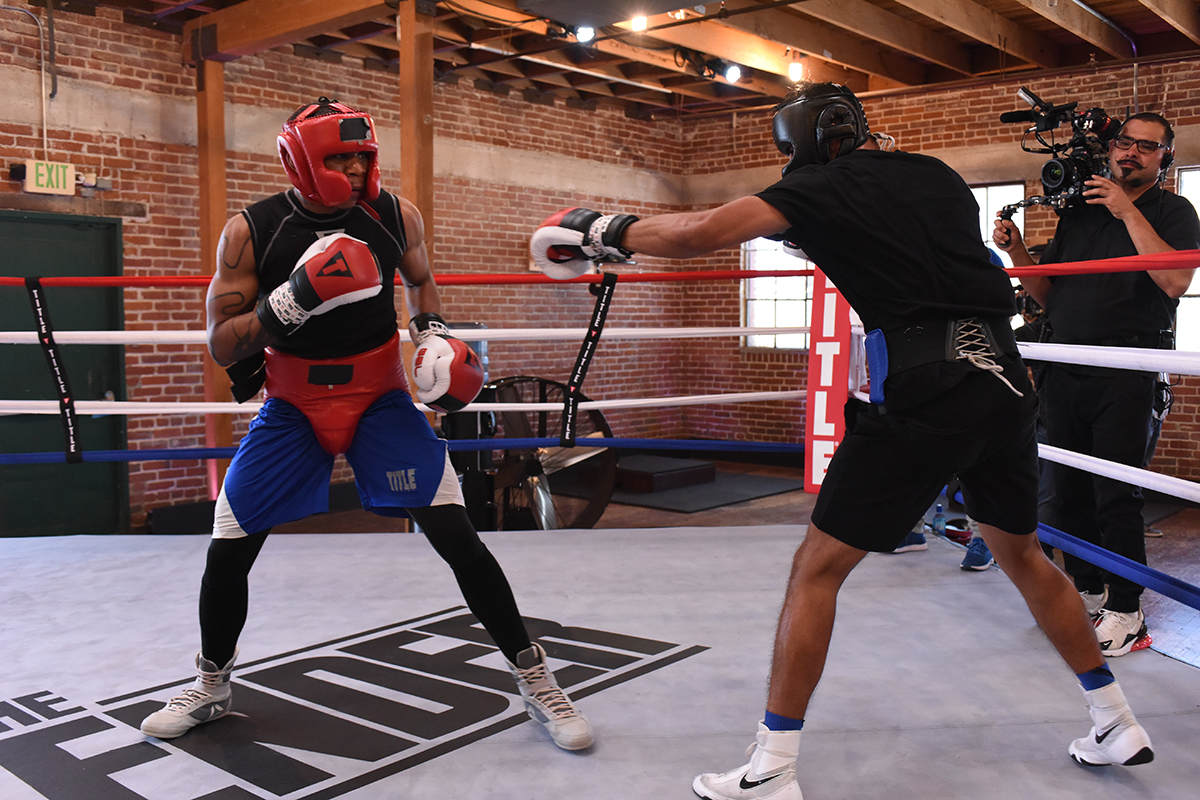
Guild reality members score a TKO for teamwork and creativity – in and out of the ring.
The Contender, re-booted for its fifth season (on its fourth network, EPIX) is not your typical “15 minutes of fame” reality show. When Executive Producer Eric Van Wagenen hired Ramy Romany to direct Mark Burnett’s 12-episode boxing competition series, from MGM and Paramount, his vision was to convert a reality competition show into a documentary film series.
As Local 600 DP Jason Hafer explains: “Mark and Eric wanted to bring an elevated level of authenticity and heightened visual storytelling to the return of The Contender,and they gave Ramy and me full visual control to make that happen. Boxing is life to each of these 16 competitors. They train hard, beat or get beat, often get hurt – and all while their wives and kids are watching. There’s nothing fake about it.”
Shot on location at the L.A. Design Center in South Los Angeles, the sets (production design by Stuart Frossell) integrated the pre-existing wood and brick of the two formerly derelict warehouses, converted to showcase the work of the area’s many furniture manufacturers. As Hafer describes, the fight ring, grandstands, master control room, pre-fight locker room and moody hallways where the fighters would walk from locker room to arena were on the first level, “and the training room, coach’s office, and fighter’s bedrooms were upstairs,” he states. “We constructed a brick wall with hooks and nameplates. Each time a fighter lost, his nameplate was put over one of the hooks, and he would walk over and hang his gloves as he left the building.”
To follow that cinematic approach, Ramy wanted The Contender shot in 2.39:1 aspect ratio, using eight ARRI AMIRAs, one ALEXA MINI (which lived on a Ronin 2), and seven C-300 Mark IIs, rather than the Sony F800s used on the original four seasons of The Contender (which first aired in 2005 on NBC). Cinema glass was chosen over ENG lenses.
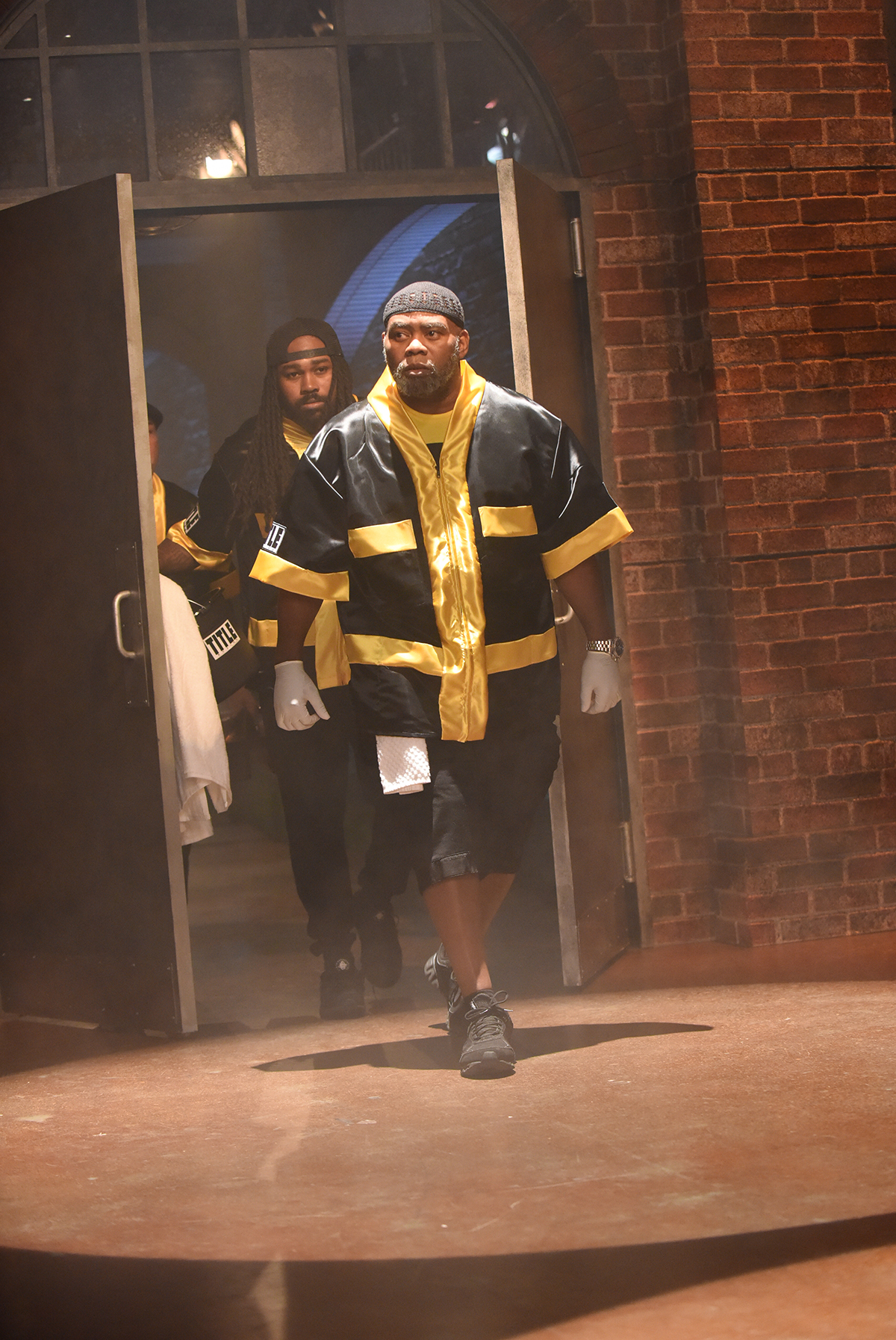
“Our operators used Sigma Cinema 18-35-millimeter and 50-100-millimeter zooms, Zeiss 70-200-millimeter zoom or the Tokina Cinema 11-16-millimeter zoom. We also carried a set of Canon CNE Primes,” Hafer shares. “We wanted it to feel like a single-camera documentary feature. We encouraged our operators to cover scenes from the approach of finding the best light and compositions, even if that meant shooting a steep profile shot or a silhouette.”
The Contender was captured in LOG-C 1920×1080 12-bit 4444, using a custom 3D LUT designed by Romany, Hafer, and colorist Dean Perme at Revolution post. “Ramy wanted to give the show a period feel that felt like film,” Hafer adds, “so we created a LUT that was low saturation, high contrast, with warm mid tones and a hint of blue/green. The blue/green in the set and the blue/green highlights fit nicely with the warm skin tones and gave the show a distinct look.” The whole show, except for the fight, was framed and matted to a 2:40 ratio.
Emmy-winning Lighting Designer and Local 600 member Oscar Dominguez created a look that was tweaked for each set and emotional moment by Lighting Director Brandon Davis.
“Reality is often lit with a baseline, and then the ambient light is brought up to what is required,” Dominguez reveals. “But The Contender was very different. When Brandon and I walked into the wonderful sets with Stuart [Frossell], Jason and Romany, we analyzed each space for ways to use the natural light like windows, without treating them too much. We always kept in mind what was happening in each room and addressing the limitations of our cameras.”
Dominguez says they used a wide range of lights, but the ones he came to call “our Swiss Army knives” were Hive’s new 100C and 200C Wasps. “They’re so small, we could put them anywhere, go for various color temperatures or full color, add reflectors or even lenses,” Dominguez adds. “This way, Brandon could mold the light to fit the room – and the situation.”
Shot in sequence over several days, shooting began with training, breaks for interplay with the host, Olympic gold medalist and undefeated retired boxer Andre Ward, and went on to face-offs, interviews, and the lonely walk to the ring on Fight Night, with master interviews, the pre-fight intensity in the locker room and finally the fight itself.
Operator Sherri Kauk recalls when she first met with Hafer and Romany, they described The Contender as a world that would bring the original Rocky (circa 1976) to life, “because each of these men is on his own Rocky journey,” Kauk offers. “We talked about establishing coverage on the shadow side, for each contender fights and dreams of being a champion in the limelight. Knowing this thematic intention, we visually framed fighters in contrast against the sun-drenched windows, in contrast to that limelight where their dreams and heroes exist.
“When they are on the speed bag,” Kauk continues, “in the ring or working the jump rope, they are facing their strengths, confronting their weaknesses; when they’re eating breakfast with, sparring with, and laying back with their competitor-housemates, they are facing the guy who will support him through his journey while actively strategizing his demise.”
The intensity of each personal story needed to be carried through the different stages. For example, during training, when fighters would do cardio, strength, and skill drills with heavy bags and speed bags, the operators needed to capture each specialized drill with the coaches and sparring partners. “Ramy wanted to maintain a certain style,” Hafer explains. “So we always wanted to keep the key upstage whenever possible using the windows that surrounded the training gym to be our upstage key/edge light.”
“We wanted to keep the warehouse feel and not polish it up,” adds Lighting Director Davis. “We used Triolet bases with 575-watt HPL bare bulbs as a general light base to keep the look industrial. We then added the Hive 100s into the practical boxing ring areas, gym equipment areas, and general reality areas for day and night.”
With so many cameras going, the AC’s worked closely, sharing lenses and doing battery runs “while sweating with the fighters in their training room,” observes Danaya Wattanapan. “We had to assist our operators without being in the way of the other cameras in the room or distracting the challengers themselves.” Camera settings changed constantly. “We would switch to different frame rates and shutter angles on the fly to capture the intensity of the fighters as they trained,” the AC continues. “Operators rotated during training sessions, handing off full camera packages, which meant breaking down and rebuilding your operators’ camera multiple times a day.”
Changing frame rates was a big deal. As Kauk says, it was both the physical and emotional journeys that would pull the audience in. As operator Dan Kavanaugh, SOC, relates: “Since boxing happens so fast, and the boxers are reacting through their training and instinct, muscle memory and what the other fighter is countering with, overlaying dialogue from a fighter’s interview with footage of them in slow motion was the best vehicle tell the story. For example, during an interview, they might be talking about a specific moment in the middle of the fight or during a training session, and slow-motion would enable us to jump away from the reality of the fight in front of us and go into a more personal perspective of our boxer during that moment.”
The style allowed the operators to get a closer look at what it means to fight for a living – but it was also a challenge for the crew in the very limited space. “There is something to be said about being in a small confined room for hours with the best technicians in the business,” Kavanaugh adds. “We needed to capture the rollercoaster ride of emotions, the boxers’ interaction with legendary trainers Freddy Roach and Naazim Richardson, and their families and friends.”
Kavanaugh says the Guild camera team “tried our best to be respectful” of the process, “shooting on the end of our lenses in cinematic tight-frame composition and playing it like a one-camera documentary style.” In fact, both locker rooms had one sound person and two operators, often shooting from the bathroom stalls! Operators did their own battery and card changes so AC’s or producers wouldn’t have to interrupt the pre- and post-fight process.
“Ramy and Jason gave Alex Wentworth, Gene Bradford and me a lot of creative freedom,” Kavanaugh continues. “We threw out the standard reality coverage rules and brought in a true docu-style cinema vérité.” With 16 fighters, all with different personalities, the operators tried to capture the quiet and introspective, as well as the amped-up and ready-to-rumble moods.
“I would try tight close-ups of their faces, headphones, small gestures with their hands or bodies – even holding a few seconds longer than might be normal,” Kavanaugh notes. “We’d also try for connection shots from the trainers or even items in the room to the boxer, finding quick moments as the boxers mentally prepared to go and fight.”
Because The Contender was truly live, there was no stopping between elements. So some of the biggest challenges were technical transitions – from the locker room to fight.
“My always-two-steps-ahead-of-me AC, Danaya, and I had about a minute to switch over to the fight mode,” Kavanaugh describes. “We had to take the camera, swap lenses, change the frame rate, change the viewfinder settings, format new cards, put fresh batteries on the camera and change the aspect ratio as we went from shooting 2.40 to 16 by 9 for the fights.”
“We were shooting so many frame rates in the arena simultaneously,” Davis adds, “that using good old-fashioned PAR cans around the boxing ring seemed like a no-brainer. We hung them in closer and shallower than we normally would to get them behind the fighters in different handheld camera shots around the ring. Oscar wanted controlled top light as well above the boxing ring. He and Stuart came up with a clever way to disguise eight Sumo space lights, which worked perfectly for playing on camera as well.”
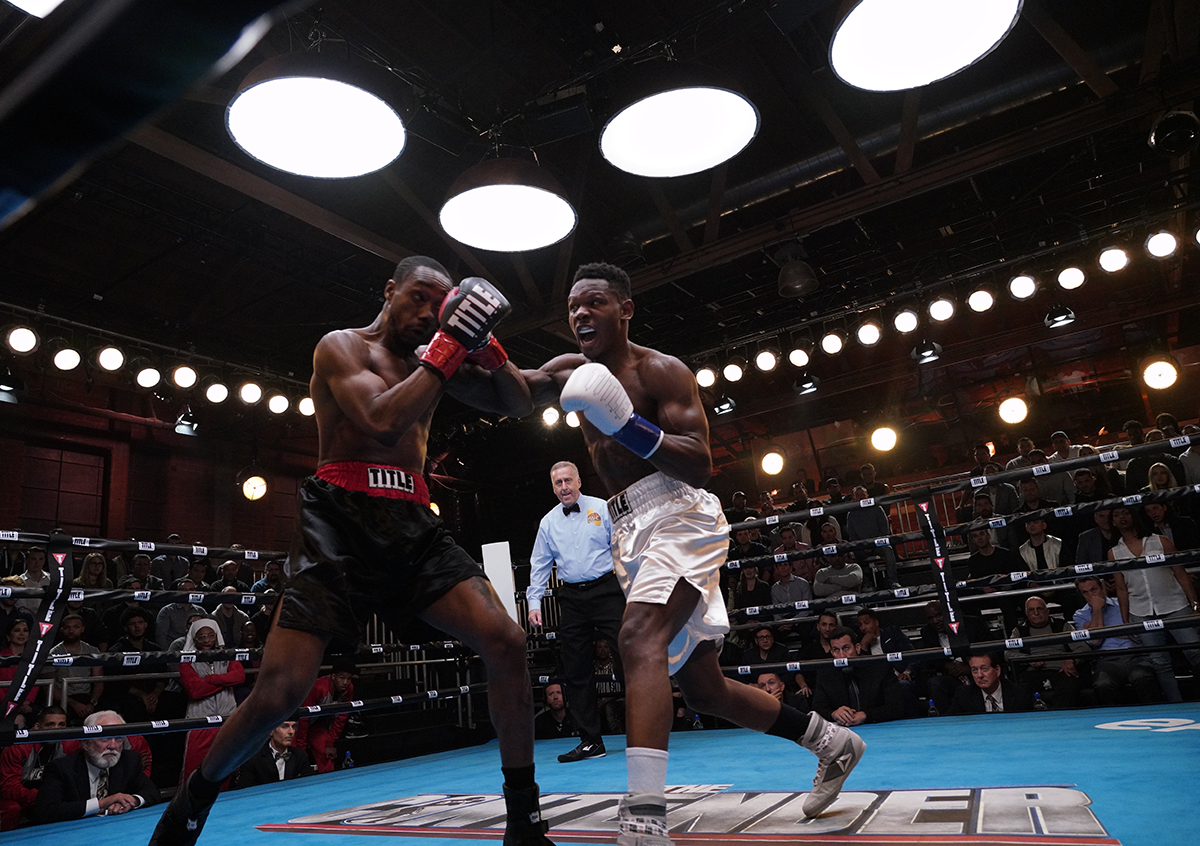
The fight itself was covered with 16 cameras. The Canon C300 Mark IIs shot real time, while the AMIRAs shot the slo-mo. The shutters on the AMIRA were at 210 degrees to capture all the detail of the blood and sweat flying off the fighters’ bodies. The 210-degree shutter angle helped by adding a little motion blur to smooth out the slow motion even more, and when the footage was converted to real time, it gave the footage a sharper look.
“Our slow motion was shot at 95.904 frames per second, which is 23.976 times four,” Hafer explains. “This allowed us to shoot the entire fight in slow motion and capture all the awesome details in camera, and if the editors wanted moments in real time, they would just speed it up times four. All cameras would shoot a timecode slate at the head of the fight for the editors to sync later. During the fight, we had two Amiras with Canon 17-120 ENG zooms outside the ropes on the apron in opposing corners, cross-shooting. An Alexa Mini, on the Ronin 2, shot low and wide through the ropes, from the side ring at ground level looking up at the fighters.”
With an AMIRA and a 50-100-millimeter lens next to the Ronin, the low/wide-angle shooting into the lights allowed Hafer to capture those exciting moments – enhanced by the light flashes.
The tighter spaces presented a healthy challenge for gimbal operator, John Lovell. Romany requested Lovell’s set up – ALEXA MINI on the Ronin 2 with the camera constantly moving. “For the majority of The Contender, I lived on a Tokina 11-16 millimeter lens,” Lovell states. “Using this wide of a lens made it a challenge to keep other operators, boom shadows, or anything else out of my frame. My field of view was always 100 degrees, even in the fight sequence. The ultra wide shot contrasted well with the other operators and their tighter shots.”
As for the other operators, they seemed to be everywhere. Two AMIRAs on Ronford standard legs with an Oconnor 2575D head and Fujinon Premier 75-400-mm zoom lenses – on platforms on the north and south sides of the ring – captured close-ups of the fighters; two more AMIRAs handheld on 50-100’s covered the teams and families; and C300 Mark IIs framed up Ward. “We got two shots of the fighters with the ropes in the foreground from a dolly in the grandstands on a 50-100 lens, wide shots from a Technocrane on a Fujinon Cabrio 14-35-millimeter ENG zoom, and even an overhead tower cam, which telescoped up and down looking directly down on the ring on an 11-16-millimeter Tokina Cine Zoom,” Hafer recounts.
The Contender’s large Guild crew put itself into the action. Literally. “There was a moment when I was crouched down in the dark hallway, in front of the pre-fight locker rooms, getting the lens and accessories ready to quickly change the camera to fight mode,” Wattanapan remembers. “I noticed there was something on the lens, so I tried to dust it off with a dry lens chamois, but that didn’t work. I pulled out my Pancro and flashlight to properly clean the lens and realized it wasn’t dust. There was dried blood on the lens from the previous fight! This happened several times, and it helped me understand the gravity of what was on the line.”
“I have so much appreciation and respect for everyone who worked on this season of The Contender,” Hafer concludes. “From the operators who fought through some long emotional scenes and never gave up on the story, to the AC’s who stayed on top of the constant camera body and lens swaps, to our LD, Brandon Davis, and Bill Essling, our Key Grip, whose teams were rock-solid from start to finish. Each department supported each other completely – and it shows in the final product. This is one we’re all very proud of.”
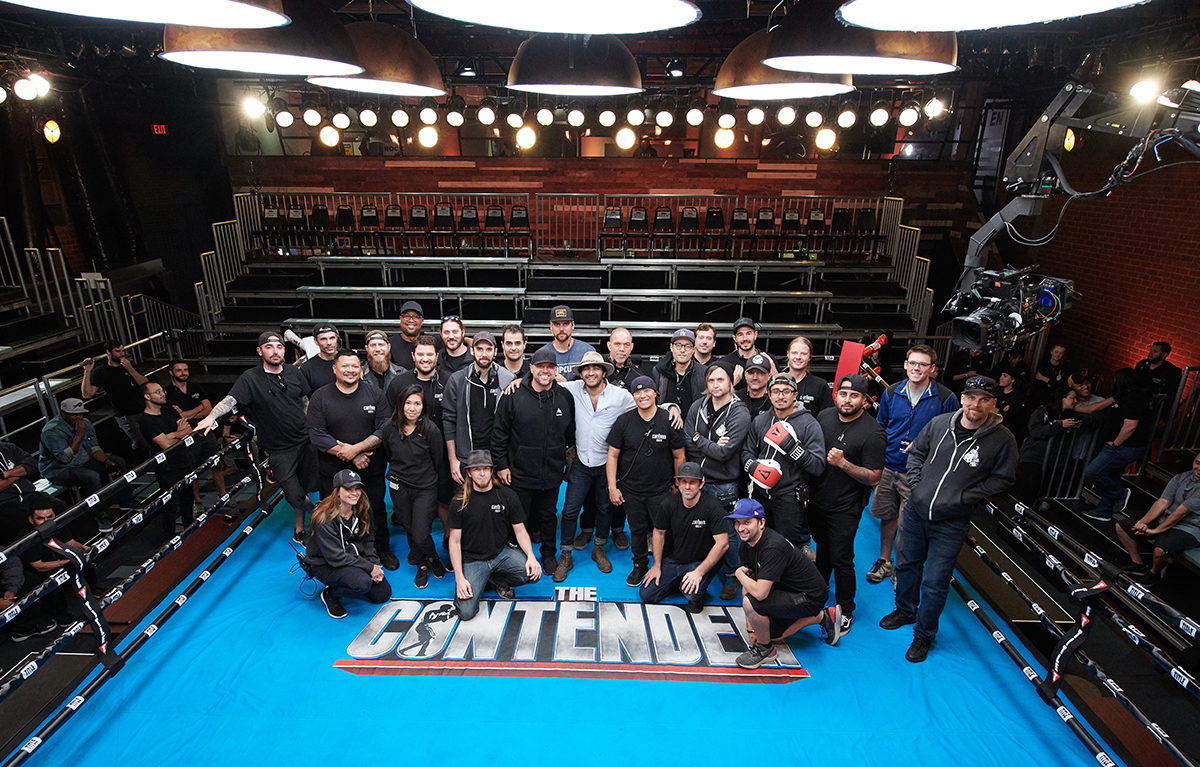
by Pauline Rogers / Framegrabs Courtesy of EPIX
LOCAL 600 CREW
The Contender – Season 5
Director of Photography: Jason Hafer
Lighting Director: Brandon Davis
Operators
Vince Acosta
MacGregor Barron
Parker Bell
Gene Bradford
Rob Cammidge
Andrei Cranach
Michael Dean, SOC
Malkuth Frahm
Alex Garcia
Brandon Haberman
Daniel Hagouel
Sherri Kauk
Dan Kavanaugh, SOC
Mitch Kim
Tayler Knight
Andrew Kwon
Chris Lobreglio, SOC
John Lovell
Art Peña
Dana Pustetta
Dax Rhorer, SOC
Sharra Romany, SOC
Brett Smith
Andy Waruszewski
Alex Wentworth
Lead AC
Josh Kade
Assistants
Corey Bringas
Josh Collinsworth
Thor Fridleifsson
Rickie Gustilo
Matt Hackbarth
Dave Hawes
Ronnen Horovitz
Will Im
Orlin Ivanov
Cameron Kahangi
Ian Mosley
Armando Muñoz
Chad Nagel
Tony Perez
Joe Prudente
Bernie Smith
Mike Warfel
Danaya Wattanapan
Utilities
Chris Savage
Bear Johnson
DIT: Jack Damon
Still Photographers
Michael Becker
Ray Mickshaw
